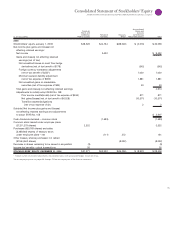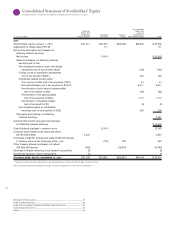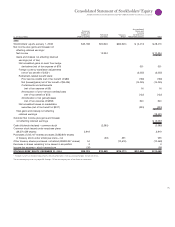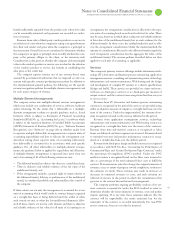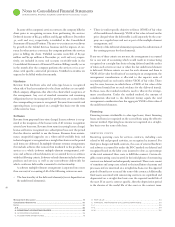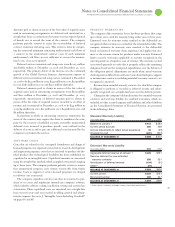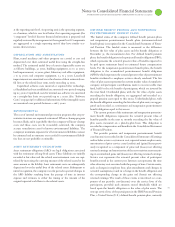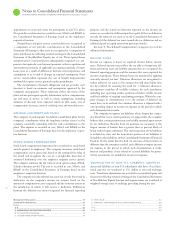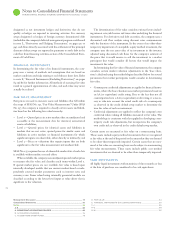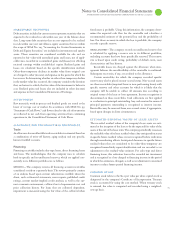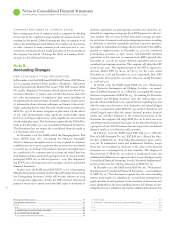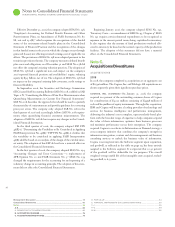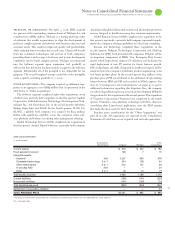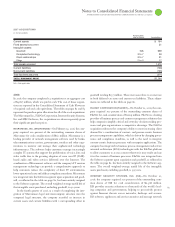IBM 2008 Annual Report Download - page 73
Download and view the complete annual report
Please find page 73 of the 2008 IBM annual report below. You can navigate through the pages in the report by either clicking on the pages listed below, or by using the keyword search tool below to find specific information within the annual report.
Notes to Consolidated Financial Statements
INTERNATIONAL BUSINESS MACHINES CORPORATION and Subsidiary Companies
at the reporting unit level. A reporting unit is the operating segment,
or a business, which is one level below that operating segment (the
“component” level) if discrete financial information is prepared and
regularly reviewed by management at the segment level. Components
are aggregated as a single reporting unit if they have similar eco-
nomic characteristics.
Plant, rental machines and other property are carried at cost and
depreciated over their estimated useful lives using the straight-line
method. The estimated useful lives of certain depreciable assets are
as follows: buildings, years; building equipment, to years;
land improvements, years; plant, laboratory and office equipment,
to years; and computer equipment, . to years. Leasehold
improvements are amortized over the shorter of their estimated use-
ful lives or the related lease term, rarely exceeding years.
Capitalized software costs incurred or acquired after technologi-
cal feasibility has been established are amortized over periods ranging
up to years. Capitalized costs for internal-use software are amortized
on a straight-line basis over periods up to years. (See “Software
Costs” on page for additional information). Other intangible assets
are amortized over periods between and years.
The cost of internal environmental protection programs that are pre-
ventative in nature are expensed as incurred. When a cleanup program
becomes likely, and it is probable that the company will incur cleanup
costs and those costs can be reasonably estimated, the company
accrues remediation costs for known environmental liabilities. The
company’s maximum exposure for all environmental liabilities cannot
be estimated and no amounts are recorded for environmental liabili-
ties that are not probable or estimable.
Asset retirement obligations (ARO) are legal obligations associated
with the retirement of long-lived assets. These liabilities are initially
recorded at fair value and the related asset retirement costs are capi-
talized by increasing the carrying amount of the related assets by the
same amount as the liability. Asset retirement costs are subsequently
depreciated over the useful lives of the related assets. Subsequent to
initial recognition, the company records period-to-period changes in
the ARO liability resulting from the passage of time in interest
expense and revisions to either the timing or the amount of the
original expected cash flows to the related assets.
The funded status of the company’s defined benefit pension plans
and nonpension postretirement benefit plans (retirement-related
benefit plans) is recognized in the Consolidated Statement of Finan-
cial Position. The funded status is measured as the difference
between the fair value of plan assets and the benefit obligation at
December , the measurement date. For defined benefit pension
plans, the benefit obligation is the projected benefit obligation (PBO),
which represents the actuarial present value of benefits expected to
be paid upon retirement based on estimated future compensation
levels. For the nonpension postretirement benefit plans, the benefit
obligation is the accumulated postretirement benefit obligation
(APBO), which represents the actuarial present value of postretirement
benefits attributed to employee services already rendered. The fair
value of plan assets represents the current market value of cumulative
company and participant contributions made to an irrevocable trust
fund, held for the sole benefit of participants, which are invested by
the trust fund. Overfunded plans, with the fair value of plan assets
exceeding the benefit obligation, are aggregated and recorded as a
prepaid pension asset equal to this excess. Underfunded plans, with
the benefit obligation exceeding the fair value of plan assets, are aggre-
gated and recorded as a retirement and nonpension postretirement
benefit obligation equal to this excess.
The current portion of the retirement and nonpension postretire-
ment benefit obligations represents the actuarial present value of
benefits payable in the next months exceeding the fair value of
plan assets, measured on a plan-by-plan basis. This obligation is
recorded in compensation and benefits in the Consolidated Statement
of Financial Position.
Net periodic pension and nonpension postretirement benefit
cost/(income) is recorded in the Consolidated Statement of Earnings
and includes service cost, interest cost, expected return on plan assets,
amortization of prior service costs/(credits) and (gains)/losses previ-
ously recognized as a component of gains and
(l
osses) not affecting
retained earnings and amortization of the net transition asset remain-
ing in accumulated gains and
(l
osses) not affecting retained earnings.
Service cost represents the actuarial present value of participant
benefits earned in the current year. Interest cost represents the time
value of money cost associated with the passage of time. Certain events,
such as changes in employee base, plan amendments and changes in
actuarial assumptions, result in a change in the benefit obligation and
the corresponding change in the gains and
(l
osses) not affecting
retained earnings. The result of these events is amortized as a com-
ponent of net periodic cost/(income) over the service lives of the
participants, provided such amounts exceed thresholds which are
based upon the benefit obligation or the value of plan assets. The
average service lives of the participants in the IBM Personal Pension
Plan, a United States (U.S.) defined benefit pension plan, currently




